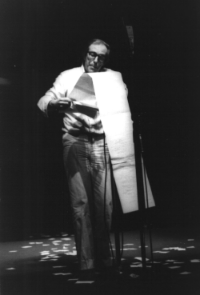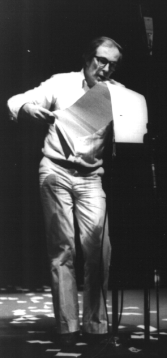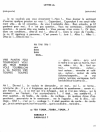Bernard Heidsieck
 Bernard Heidsieck
performing Vaduz at the
Bernard Heidsieck
performing Vaduz at the
11th International Sound Poetry Festival, Toronto, 1978.
Photos by Larry Wendt.
Bernard Heidsieck began working at 'projecting the word from
the page' in the late fifties with his poèm-partition pieces
which were short poem-scores which used straight forward typographical
variations and space as a system of cues to be articulated in a live
performance situation. In this regard, he called his work poésie
action and he would often include some physical gestures to help the
audience visualize the text.
In the sixties he started working with tape recorders to
produce works which he organized in various functional categories such as
exorcisme, biopsie, and passe-partout. With his
pass-partout pieces for example. Snatches of repeated phrases,
environmental sounds, and cliches were moulded together to form an epiphanal
'universal pass-key' that would reveal something about the reality from which
the language and sounds were taken from. Heidsieck evolved these techniques
even further in a series of works done between 1974 and 1976 titled Canal
Street. These were derived from 50 word and phrase collages made from
documents about communication devices which he had found at the electronic
surplus stores on Canal Street in New York.  After the completion of this work,
Heidsieck did another series of pieces known as Deriche Le Robert. It
was a collection of 26 pieces each based on the listings for each letter of the
alphabet in the then new edition of the famous French dictionary, Le
Robert.
After the completion of this work,
Heidsieck did another series of pieces known as Deriche Le Robert. It
was a collection of 26 pieces each based on the listings for each letter of the
alphabet in the then new edition of the famous French dictionary, Le
Robert.
In the real-time performance of his works, Heidsieck makes
use of tape recordings which can contain readings done by him of his texts, and
to which he interacts vocally. As such, these tapes act as another kind of
score and providing a pattern from which the piece is evolved from. The
tape/score can contain other sounds as well that set up a context for the
piece. He also often uses simple props (such as a glass, a telephone or a desk)
and different sitting postures to convey meaning.
His text/scores are unencumbered with interpretable visual
cues which go beyond the printed word. The appearance of the words on the page,
is less significant for him than it might be for other sound poets. That he
'reads' such texts rather than perform them from memory, also is revealing of
what he is attempting to do with his work. The written word has robbed language
of much of its expressive power and has reduced it to an internalized voice
that has no physical boundaries or reality. That language exists as a secondary
abstraction in the form of the written word, has the consequence of erasing the
significance of the spoken word. By reading the written word aloud and
'projecting the word off the page,' as Heidsieck describes it, one revivifies
the word and returns it to the realm of the senses and bodily authenticity.
Heidsieck's readings are generally very intense affairs. On
stage he is like a tightened spring ready to suddenly snap. Each word is
delivered with a diction and a concentration that is powerful and even somewhat
unnerving at times. It is of the utmost importance to him that he performs his
work with all of the strength which he can muster. The act of reading is a
visceral and even desperate act in his hands and he squeezes out as much energy
from each word that he possibly can. This is also the basis for why he does not
do choral sound poetry works or allows his work to be performed by others. The
voice behind his words are unique, and its timbral individuality that gives his
language a soul can only be registered as a recording, the mimicking by another
destroys what the piece is.
In Heidsieck's recent series of works (which number over 50
now), Breaths and Brief Encounters, he has an imaginary dialog with a
dead poet. This 'conversation' is performed on stage against a tape containing
a 'loop' of inhaled breath sounds made by the poet while recording their own
poetry. Occasionally there are other sounds on the tape as well, such as the
pouring of a drink in his Encounter with Dylan Thomas, or bird sounds
that were recorded in the garden where Ezra Pound last lived, in his
Encounter with Ezra Pound.
It is interesting how individual and recognizable these
breath sounds are of the particular poet, especially if one was familiar with
the poet's voice when they were alive. Such recognizability makes these very
haunting and effective pieces. The mechanical rhythm of the breath evokes a
sense of 'deadness', and listening to these works is reminiscent of looking
into the eyes of a face which has been captured in a well-made hologram.
That there are more unvoiced inhaled sounds than exhaled
ones during the recording of a reading, is a fortuitous situation in regards to
these works since that act carries a certain amount symbolic luggage. Death is
usually associated with an exhalation where the first breath of life is
associated with inhalation. By collecting the inhaled sound, the poet can
mechanically be 'brought back to life' as a sonic automaton, and momentarily
reversing the order of the relationship between breath, voice, and life.
The sounds of one's own breath provides bookends for the
history of one's life. How and when we take a breath is the most personalizing
and individualistic aspect of our voice and therefore is at the root of our
unique personalities. These sounds have been written out of our literature and
erased from our memories by the 'civilizing' and abstracting processes of
literacy. Writing takes away the uniqueness of breath by reinforcing the inner
voice which makes us deaf to the sound of our true voice. The inner voice has
no breath or interruption. It gives one the absurd notion that life is eternal,
interchangeable with one another, and non-unique. We are no longer reminded of
the irreversibility of life's narrative by breath's constant interruption. A
dialogue with that which disrupts the voice and therefore its history, brings
one back to their sense of reality and uniqueness. The individual sound of
breath, unencumbered by the fetters of phonemic abstraction and restrictions,
is perhaps therefore a poet's most perfect poem, and as such, Heidsieck's
pieces, work as homages to the poet's subtle sense of reality and humanity.
Some of Heidsieck's other recordings include:
Canal Street (Paris: SEVIM/Bernard Heidsieck 3 LPs, 1986).
P Puissance B (Naples: Edizioni Lotta Poetica & Studio Morra,
Radio Taxi No. 7, LP, 1983)
"Trois Biopsies" + "Un Passe-Partout" (Paris:
Multi-Techniques, LP c. 1970).
Partition V (Paris: Le Soleil Noir, Six records and a book, 1973).
Poèmes Partition D2 and D3Z (Ingatestone: Collection OU, two
records and a book, 1973).
There is a World Wide Web
site in
Australia which contains biblio/biographical material about Bernard Heidsieck
as well as a short audio sample from Canal Street.

Last Modified 21 January 1998
 Bernard Heidsieck
performing Vaduz at the
Bernard Heidsieck
performing Vaduz at the 
